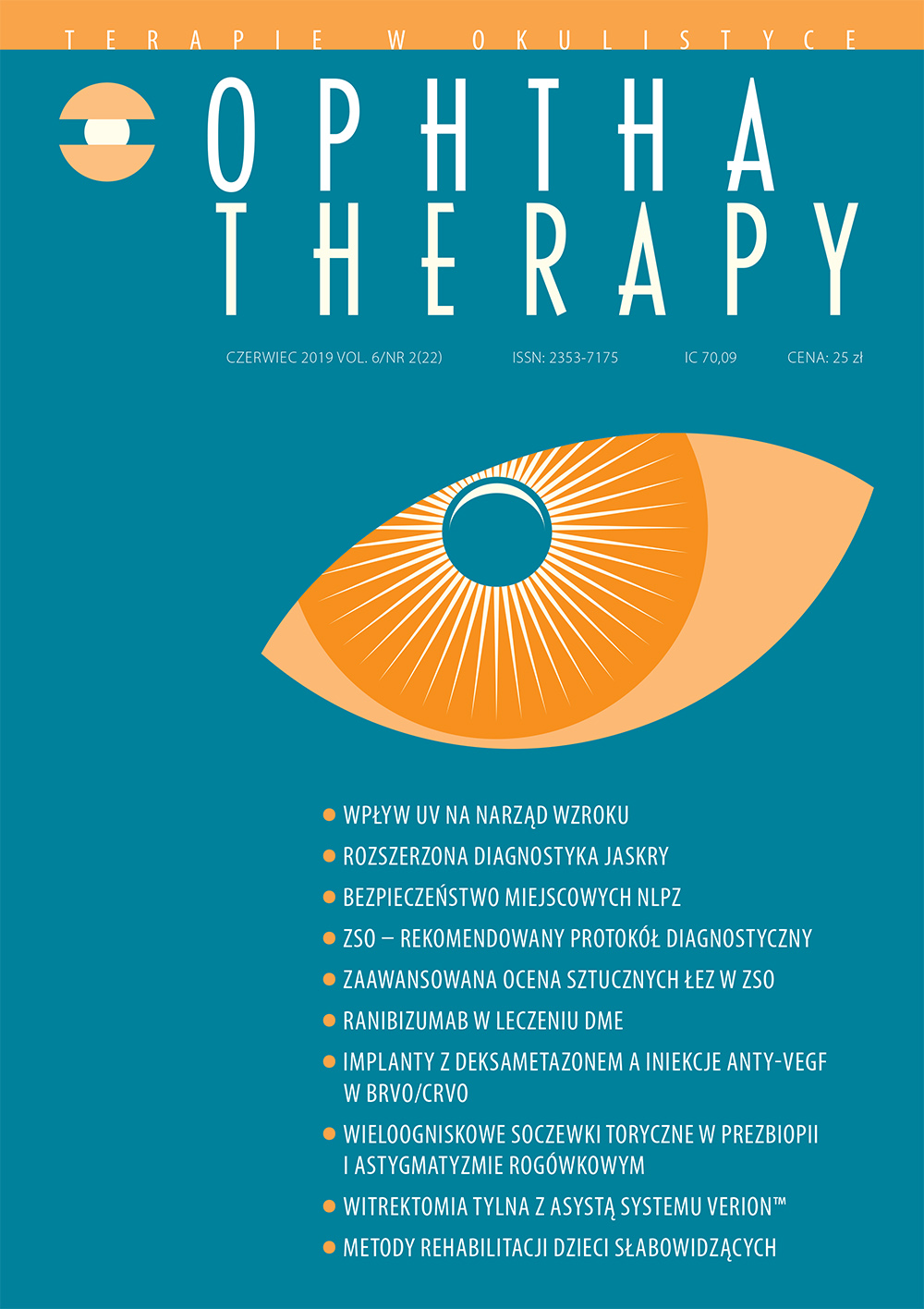The recommended diagnostic protocol for dry eye disease
Main Article Content
Abstract
The prevalence of ocular surface abnormalities, including dry eye disease, has been reported to increase over the last decade [1]. Dry eye incidence increases with age, however is notable among young adults. The disease affects half of the global population with one-fifth of the patients being undiagnosed. The lack of standardized diagnostic criteria results in a wide range of reported prevalence rates (ranging from 5–75%). Dry Eye Workshop II report summarizes a decade of important clinical studies and provides a new definition of the disease [2] and systematic clinical diagnostic protocol [3]. This protocol, provided below, enables the practitioner to perform full objective dry eye diagnosis
Downloads
Article Details

This work is licensed under a Creative Commons Attribution-NonCommercial-NoDerivatives 4.0 International License.
Copyright: © Medical Education sp. z o.o. License allowing third parties to copy and redistribute the material in any medium or format and to remix, transform, and build upon the material, provided the original work is properly cited and states its license.
Address reprint requests to: Medical Education, Marcin Kuźma (marcin.kuzma@mededu.pl)
References
2. Dana R, Bradley JL, Guerin A et al. Estimated Prevalence and Incidence of Dry Eye Disease Based on Coding Analysis of a Large, Allage United States Health Care System. Am J Ophthalmol. 2019; 202: 47-54.
3. Farrand KF, Fridman M, Stillman IÖ et al. Prevalence of diagnosed dry eye disease in the United States among adults aged 18 years and older. Am J Ophthalmol. 2017; 182: 90-8. https://doi.org/ 10.1016/j.ajo.2017.06.033.
4. Craig JP, Nichols KK, Akpek EK et al. TFOS DEWS II definition and classification report. Ocul Surf. 2017; 15(3): 276-83.
5. Wolffsohn JS, Arita R, Chalmers R et al. TFOS DEWS II diagnostic methodology report. Ocul Surf. 2017; 15(3): 539-74.
6. Craig JP, Nelson JD, Azar DT et al. TFOS DEWS II report executive summary. Ocul Surf. 2017; 15(4): 802-12.
7. Matossian C, McDonald M, Donaldson KE et al. Dry Eye Disease: Consideration for Women’s Health. J Women’s Health. 2019; 28(4): 502-14.
8. Vehof J, Smitt-Kamminga NS, Nibourg SA et al. Sex differences in clinical characteristics of dry eye disease. Ocul Surf. 2018; 16(2): 242-8.
9. Ward MF, Le P, Donaldson JC et al. Racial and Ethnic Differences in the Association Between Diabetes Mellitus and Dry Eye Disease. Ophthalmic Epidemiol. 2019. Apr 26: 1-6. https://doi.org/ 10.1080/09286586.2019.1607882.
10. Mo Z, Fu Q, Lyu D et al. Impacts of air pollution on dry eye disease among residents in Hangzhou, China: A case-crossover study. Environ Pollut. 2019; 246: 183-9.
11. Alex A, Edwards A, Daniel Hays J et al. Factors predicting the ocular surface response to desiccating environmental stress. Invest Ophthalmol Vis Sci. 2013; 54(5): 3325-32.
12. Schaumberg DA, Sullivan DA, Buring JE et al. Prevalence of dry eye syndrome among US women. Am J Ophthalmol. 2003; 136(2): 318-26.
13. Moss SE, Klein R, Klein BEK. Prevalence of and risk factors for dry eye syndrome. Arch Ophthalmol. 2000; 118(9): 1264-8.
14. Nichols KK, Nichols JJ, Mitchell GL. The lack of association between signs and symptoms in patients with dry eye disease. Cornea. 2004; 23(8): 762-70.
15. Pult H, Purslow C, Murphy PJ. The relationship between clinical signs and dry eye symptoms. Eye. 2011; 25(4): 502.
16. Sullivan B. Challenges in using signs and symptoms to evaluate new biomarkers of dry eye disease. Ocul Surf. 2014; 12(1): 2-9.
17. Schiffman RM, Christianson MD, Jacobsen G et al. Reliability and validity of the ocular surface disease index. Arch Ophthalmol. 2000; 118(5): 615-21.
18. Chalmers RL, Begley CG, Caffery B. Validation of the 5-Item Dry Eye Questionnaire (DEQ-5): Discrimination across self-assessed severity and aqueous tear deficient dry eye diagnoses. Contact Lens Anterior Eye. 2010; 33(2): 55-60.
19. Li M, Gong L, Chapin WJ et al. Assessment of vision-related quality of life in dry eye patients. Invest Ophthalmol Vis Sci. 2012; 53(9): 5722-7.
20. Begley CG, Chalmers RL, Abetz L et al. The Relationship between Habitual Patient-Reported Symptoms and Clinical Signs among Patients with Dry Eye of Varying Severity. Invest Ophthalmol Vis Sci. 2003; 44(11): 4753-61.
21. Vitali C, Moutsopoulos HM, Bombardieri S. The European Community Study Group on diagnostic criteria for Sjögren’s syndrome. Sensitivity and specificity of tests for ocular and oral involvement in Sjögren’s syndrome. Ann Rheum Dis. 1994; 53(10): 637.
22. Hong J, Sun X, Wei A et al. Assessment of tear film stability in dry eye with a newly developed keratograph. Cornea. 2013; 32(5): 716-21.
23. Mengher LS, Bron AJ, Tonge SR et al. A non-invasive instrument for clinical assessment of the pre-corneal tear film stability. Curr Eye Res. 1985; 4: 1-7.
24. Tomlinson A, Khanal S. Assessment of tear film dynamics: quantification approach. Ocul Surf. 2005; 3(2): 81-95.
25. Lemp MA, Bron AJ, Baudouin C et al. Tear osmolarity in the diagnosis and management of dry eye disease. Am J Ophthalmol. 2011; 151(5): 792-8.e1.
26. Nemeth J, Fodor E, Lang Z et al. Lid-parallel conjunctival folds (LIPCOF) and dry eye: a multicentre study. Br J Ophthalmol. 2012; 96(11): 1380-5.
27. Knop E, Knop N, Millar T et al. The international workshop on meibomian gland dysfunction: report of the subcommittee on anatomy, physiology, and pathophysiology of the meibomian gland. Invest Ophthalmol Vis Sci. 2011; 52(4): 1938-78.
28. Ban Y, Shimazaki-Den S, Tsubota K et al. Morphological evaluation of meibomian glands using noncontact infrared meibography. Ocul Surf. 2013; 11(1): 47-53.
29. Segev F, Geffen N, Galor A et al. Dynamic assessment of the tear film muco-aqueous and lipid layers using a novel tear film imager (TFI). Br J Ophthalmol. 2019 Apr 18. pii: bjophthalmol-2018-313379. https://doi.org/ 10.1136/bjophthalmol-2018-313379.

